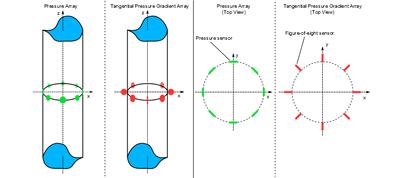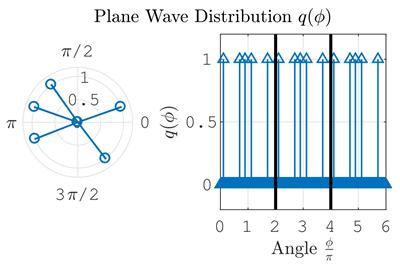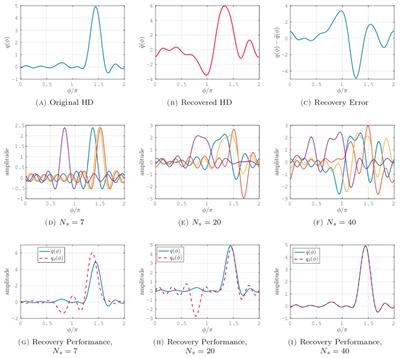Research project: Next Generation Recording Technology
Developing a microphone array with tangentially aligned pressure gradient sensors in combination with a novel spatial de-aliasing strategy.
Developing a microphone array with tangentially aligned pressure gradient sensors in combination with a novel spatial de-aliasing strategy.
Introduction
Over the past century, microphone arrays of different geometries have been the subject of acoustics research. Like many other types of sensor arrays, they simply serve the purpose of acquiring data of a sound field at a few discrete points. In combination with an adequate wave field model, the acquired data can be used to reconstruct the entire wave field both, physically and virtually. In other words, the sound field is known at any point in space that lies within the original model during the time of the recording.
The ability to reconstruct a wave field implies that the data observed by the array carries sufficient information on the original wave field. Such an ambitious objective necessitates a sound mathematical model of the physics of any possible wave field under consideration and the sensor technology to keep the practical limitations of the model down to an acceptable level.
But a microphone array and the sound field model it is based on should not only be judged by its baseline performance but also by the potential it bears for further signal processing. A carefully designed post-processing of the acquired sound field data can further improve the performance of the overall system. We attempt to address all three aspects in our research.

Tangential Pressure Gradient Sensor Array
What makes a sensor array design particularly interesting is the interpretation of the acquired data on the basis of an adequate wave field model. Ever since the first microphone array proposed by Alan Blumlein, the vast majority of designs rely on pressure sensors. Motivated by an initial study presented by Craven, Travis and Malcolm [1], we have been investigating the potential of arrays that apply pressure gradient sensors that are aligned tangentially to the arrayís measurement boundary.

DOA Estimation through a Finite Rate of Innovation Data Model
When using microphone arrays, it has ever been a key challenge to use the microphone signals to determine the directions in which acoustic sources can be found. This is also referred to as Direction-Of-Arrival (DOA) estimation. Such a technology is important for hearing aids, sonar and teleconference systems, to name a few. It relies on signal analysis and leads to a set of parameters that determine the direction of one source that can then be used for further processing (e.g. see ‘A De-Aliasing Strategy’)

We are working on a DOA estimation method [2] that is based on a ‘Finite Rate of Innovation’ assumption [3] for the sound field model. When looking at the horizontal plane (i.e. the 2D-case), that means that there can only be a finite number of sources (i.e. plane waves) in the sound field, each of which has a distinct direction (see Figure 1).
The proposed method not only determines the direction of a source but also the ‘strength’ of the source, as can be seen in result shown in the Figure 2.

A Post-Processing De-Aliasing Strategy
We are working on a signal processing strategy that seeks to tackle spatial aliasing, i.e. the ambiguity of the direction of incidence for an acoustic wave that occurs at high frequencies. Using a sound field model with a finite number of sources, the data recovered from the optimum frequency band of an existing microphone array can be used to identify the direction of these ‘principal’ sources. Assuming that the sources in the sound field are radiating over a wide frequency band, it can be assumed that the wave field at high frequencies originates from the same sources as those identified at lower frequencies at which no aliasing occurs. Using an aliasing model for single plane waves, the ambiguity at higher frequencies can then be resolved and their effects successfully removed from the observed data.
Falk-Martin Hoffman, Filippo Fazi
[1] P. G. Craven, M. J. Law, C. Travis, “Microphone arrays using tangential velocity sensors”, in Ambisonics Symposium, June 2009
[2] F.-M. Hoffmann, F. M. Fazi, P. A. Nelson, “Plane Wave Identification with Circular Arrays by Means of a Finite Rate of Innovation Approach”, Presented at the 140th AES Convention, June 2016
[3] M. Vetterli, P. Marziliano, T. Blu, “Sampling signals with finite rate of innovation”, IEEE Transactions on Signal Processing, vol. 50, no. 6, pp. 1417-1428, 2002